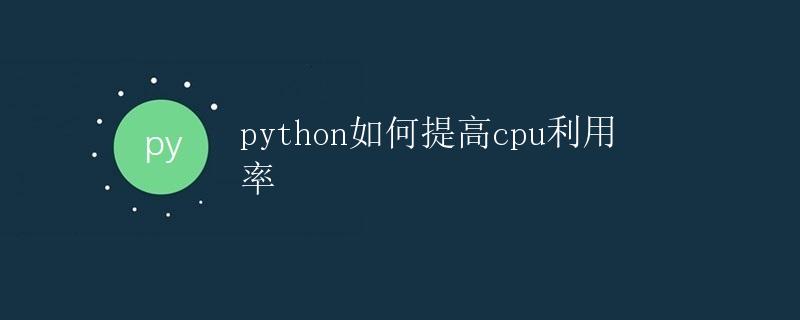How to improve CPU utilization in Python
How to Improve CPU Utilization in Python

When writing Python programs, we often need to improve CPU utilization to enhance program execution efficiency. This article will introduce some methods to help you improve CPU utilization in Python programs.
Using Multithreading
Using multithreading can fully utilize multi-core CPUs, improving program parallelism and performance. Python’s threading module provides multithreading support, allowing us to execute different tasks in different threads, thereby improving CPU utilization.
The following is a simple multithreading example code:
import threading
def task1():
for i in range(1000000):
pass
def task2():
for i in range(1000000):
pass
if __name__ == "__main__":
t1 = threading.Thread(target=task1)
t2 = threading.Thread(target=task2)
t1.start()
t2.start()
t1.join()
t2.join()
In this example, we define two tasks, task1 and task2, which are executed in two different threads. By using multithreading, we can execute these two tasks simultaneously and fully utilize CPU resources.
Using Multiprocessing
In addition to multithreading, we can also use multiprocessing to improve CPU utilization. Python’s multiprocessing module provides multiprocessing support, allowing us to execute different tasks in different processes, further improving program parallelism and performance.
The following is a simple multiprocessing example code:
import multiprocessing
def task1():
for i in range(1000000):
pass
def task2():
for i in range(1000000):
pass
if __name__ == "__main__":
p1 = multiprocessing.Process(target=task1)
p2 = multiprocessing.Process(target=task2)
p1.start()
p2.start()
p1.join()
p2.join()
In this example, we define two tasks, task1 and task2, which are executed in two different processes. By using multiprocessing, we can execute these two tasks simultaneously, further improving CPU utilization.
Using Parallel Computing Libraries
In addition to multithreading and multiprocessing, we can also use specialized parallel computing libraries to improve CPU utilization, such as joblib and dask. These libraries provide more advanced APIs and functions, making parallel computing and task scheduling more convenient.
The following is an example code using the joblib library:
from joblib import Parallel, delayed
def task(i):
for _ in range(1000000):
pass
if __name__ == "__main__":
results = Parallel(n_jobs=-1)(delayed(task)(i) for i in range(10))
In this example, we define a task task and then use the Parallel function of the joblib library to execute it in parallel. In this way, we can more easily utilize multi-core CPUs and improve CPU utilization.
Using NumPy and Numba
For some numerically intensive tasks, we can use NumPy and Numba to improve CPU utilization. NumPy is a high-performance numerical computing library, and Numba is a library for accelerating Python programs. By using these two libraries, the execution efficiency and CPU utilization of numerical computing tasks can be effectively improved.
The following is example code using NumPy and Numba:
import numpy as np
from numba import jit
@jit
def task():
x = np.random.rand(10000, 10000)
y = np.random.rand(10000, 10000)
z = np.dot(x, y)
if __name__ == "__main__":
task()
In this example, we defined a task, task, accelerated by NumPy and Numba, which performs a matrix multiplication. By using NumPy and Numba, we can fully utilize CPU resources and improve CPU utilization.
Summary
By using multithreading, multiprocessing, parallel computing libraries, NumPy, and Numba, we can effectively improve the CPU utilization of Python programs, enhancing their execution efficiency and performance. In actual development, we can choose appropriate optimization methods based on different tasks and requirements to fully utilize CPU resources and improve concurrency and performance.